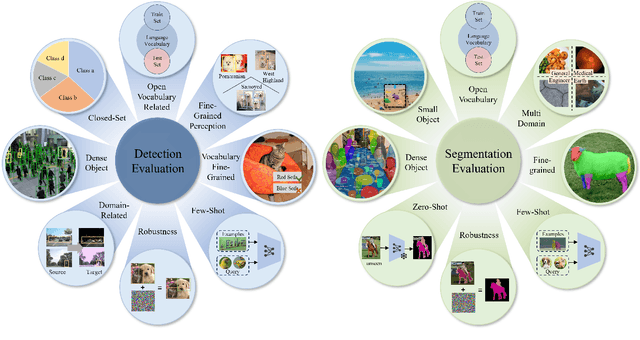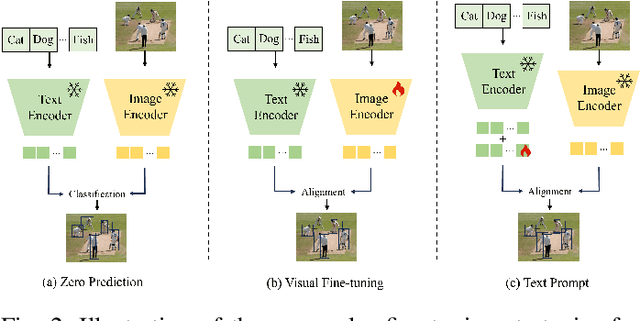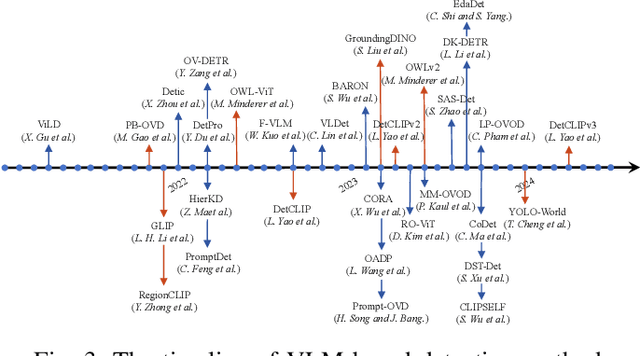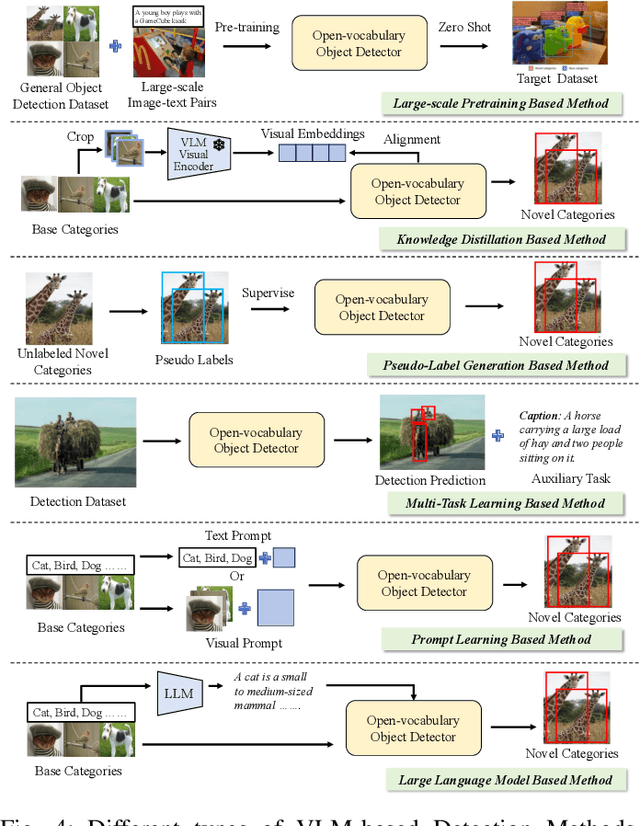Ziqi Liu
Exploring Scale Shift in Crowd Localization under the Context of Domain Generalization
Oct 22, 2025Abstract:Crowd localization plays a crucial role in visual scene understanding towards predicting each pedestrian location in a crowd, thus being applicable to various downstream tasks. However, existing approaches suffer from significant performance degradation due to discrepancies in head scale distributions (scale shift) between training and testing data, a challenge known as domain generalization (DG). This paper aims to comprehend the nature of scale shift within the context of domain generalization for crowd localization models. To this end, we address four critical questions: (i) How does scale shift influence crowd localization in a DG scenario? (ii) How can we quantify this influence? (iii) What causes this influence? (iv) How to mitigate the influence? Initially, we conduct a systematic examination of how crowd localization performance varies with different levels of scale shift. Then, we establish a benchmark, ScaleBench, and reproduce 20 advanced DG algorithms to quantify the influence. Through extensive experiments, we demonstrate the limitations of existing algorithms and underscore the importance and complexity of scale shift, a topic that remains insufficiently explored. To deepen our understanding, we provide a rigorous theoretical analysis on scale shift. Building on these insights, we further propose an effective algorithm called Causal Feature Decomposition and Anisotropic Processing (Catto) to mitigate the influence of scale shift in DG settings. Later, we also provide extensive analytical experiments, revealing four significant insights for future research. Our results emphasize the importance of this novel and applicable research direction, which we term Scale Shift Domain Generalization.
Arrows of Math Reasoning Data Synthesis for Large Language Models: Diversity, Complexity and Correctness
Aug 26, 2025Abstract:Enhancing the mathematical reasoning of large language models (LLMs) demands high-quality training data, yet conventional methods face critical challenges in scalability, cost, and data reliability. To address these limitations, we propose a novel program-assisted synthesis framework that systematically generates a high-quality mathematical corpus with guaranteed diversity, complexity, and correctness. This framework integrates mathematical knowledge systems and domain-specific tools to create executable programs. These programs are then translated into natural language problem-solution pairs and vetted by a bilateral validation mechanism that verifies solution correctness against program outputs and ensures program-problem consistency. We have generated 12.3 million such problem-solving triples. Experiments demonstrate that models fine-tuned on our data significantly improve their inference capabilities, achieving state-of-the-art performance on several benchmark datasets and showcasing the effectiveness of our synthesis approach.
Towards Greater Leverage: Scaling Laws for Efficient Mixture-of-Experts Language Models
Jul 24, 2025Abstract:Mixture-of-Experts (MoE) has become a dominant architecture for scaling Large Language Models (LLMs) efficiently by decoupling total parameters from computational cost. However, this decoupling creates a critical challenge: predicting the model capacity of a given MoE configurations (e.g., expert activation ratio and granularity) remains an unresolved problem. To address this gap, we introduce Efficiency Leverage (EL), a metric quantifying the computational advantage of an MoE model over a dense equivalent. We conduct a large-scale empirical study, training over 300 models up to 28B parameters, to systematically investigate the relationship between MoE architectural configurations and EL. Our findings reveal that EL is primarily driven by the expert activation ratio and the total compute budget, both following predictable power laws, while expert granularity acts as a non-linear modulator with a clear optimal range. We integrate these discoveries into a unified scaling law that accurately predicts the EL of an MoE architecture based on its configuration. To validate our derived scaling laws, we designed and trained Ling-mini-beta, a pilot model for Ling-2.0 series with only 0.85B active parameters, alongside a 6.1B dense model for comparison. When trained on an identical 1T high-quality token dataset, Ling-mini-beta matched the performance of the 6.1B dense model while consuming over 7x fewer computational resources, thereby confirming the accuracy of our scaling laws. This work provides a principled and empirically-grounded foundation for the scaling of efficient MoE models.
WSM: Decay-Free Learning Rate Schedule via Checkpoint Merging for LLM Pre-training
Jul 23, 2025Abstract:Recent advances in learning rate (LR) scheduling have demonstrated the effectiveness of decay-free approaches that eliminate the traditional decay phase while maintaining competitive performance. Model merging techniques have emerged as particularly promising solutions in this domain. We present Warmup-Stable and Merge (WSM), a general framework that establishes a formal connection between learning rate decay and model merging. WSM provides a unified theoretical foundation for emulating various decay strategies-including cosine decay, linear decay and inverse square root decay-as principled model averaging schemes, while remaining fully compatible with diverse optimization methods. Through extensive experiments, we identify merge duration-the training window for checkpoint aggregation-as the most critical factor influencing model performance, surpassing the importance of both checkpoint interval and merge quantity. Our framework consistently outperforms the widely-adopted Warmup-Stable-Decay (WSD) approach across multiple benchmarks, achieving significant improvements of +3.5% on MATH, +2.9% on HumanEval, and +5.5% on MMLU-Pro. The performance advantages extend to supervised fine-tuning scenarios, highlighting WSM's potential for long-term model refinement.
Measuring Fine-Grained Relatedness in Multitask Learning via Data Attribution
May 27, 2025Abstract:Measuring task relatedness and mitigating negative transfer remain a critical open challenge in Multitask Learning (MTL). This work extends data attribution -- which quantifies the influence of individual training data points on model predictions -- to MTL setting for measuring task relatedness. We propose the MultiTask Influence Function (MTIF), a method that adapts influence functions to MTL models with hard or soft parameter sharing. Compared to conventional task relatedness measurements, MTIF provides a fine-grained, instance-level relatedness measure beyond the entire-task level. This fine-grained relatedness measure enables a data selection strategy to effectively mitigate negative transfer in MTL. Through extensive experiments, we demonstrate that the proposed MTIF efficiently and accurately approximates the performance of models trained on data subsets. Moreover, the data selection strategy enabled by MTIF consistently improves model performance in MTL. Our work establishes a novel connection between data attribution and MTL, offering an efficient and fine-grained solution for measuring task relatedness and enhancing MTL models.
Faithful Group Shapley Value
May 25, 2025Abstract:Data Shapley is an important tool for data valuation, which quantifies the contribution of individual data points to machine learning models. In practice, group-level data valuation is desirable when data providers contribute data in batch. However, we identify that existing group-level extensions of Data Shapley are vulnerable to shell company attacks, where strategic group splitting can unfairly inflate valuations. We propose Faithful Group Shapley Value (FGSV) that uniquely defends against such attacks. Building on original mathematical insights, we develop a provably fast and accurate approximation algorithm for computing FGSV. Empirical experiments demonstrate that our algorithm significantly outperforms state-of-the-art methods in computational efficiency and approximation accuracy, while ensuring faithful group-level valuation.
Relation-Aware Graph Foundation Model
May 17, 2025Abstract:In recent years, large language models (LLMs) have demonstrated remarkable generalization capabilities across various natural language processing (NLP) tasks. Similarly, graph foundation models (GFMs) have emerged as a promising direction in graph learning, aiming to generalize across diverse datasets through large-scale pre-training. However, unlike language models that rely on explicit token representations, graphs lack a well-defined unit for generalization, making it challenging to design effective pre-training strategies. In this work, we propose REEF, a novel framework that leverages relation tokens as the basic units for GFMs. Inspired by the token vocabulary in LLMs, we construct a relation vocabulary of relation tokens to store relational information within graphs. To accommodate diverse relations, we introduce two hypernetworks that adaptively generate the parameters of aggregators and classifiers in graph neural networks based on relation tokens. In addition, we design another hypernetwork to construct dataset-specific projectors and incorporate a dataset-level feature bias into the initial node representations, enhancing flexibility across different datasets with the same relation. Further, we adopt graph data augmentation and a mixed-dataset pre-training strategy, allowing REEF to capture relational diversity more effectively and exhibit strong generalization capabilities. Extensive experiments show that REEF significantly outperforms existing methods on both pre-training and transfer learning tasks, underscoring its potential as a powerful foundation model for graph-based applications.
POLYRAG: Integrating Polyviews into Retrieval-Augmented Generation for Medical Applications
Apr 21, 2025Abstract:Large language models (LLMs) have become a disruptive force in the industry, introducing unprecedented capabilities in natural language processing, logical reasoning and so on. However, the challenges of knowledge updates and hallucination issues have limited the application of LLMs in medical scenarios, where retrieval-augmented generation (RAG) can offer significant assistance. Nevertheless, existing retrieve-then-read approaches generally digest the retrieved documents, without considering the timeliness, authoritativeness and commonality of retrieval. We argue that these approaches can be suboptimal, especially in real-world applications where information from different sources might conflict with each other and even information from the same source in different time scale might be different, and totally relying on this would deteriorate the performance of RAG approaches. We propose PolyRAG that carefully incorporate judges from different perspectives and finally integrate the polyviews for retrieval augmented generation in medical applications. Due to the scarcity of real-world benchmarks for evaluation, to bridge the gap we propose PolyEVAL, a benchmark consists of queries and documents collected from real-world medical scenarios (including medical policy, hospital & doctor inquiry and healthcare) with multiple tagging (e.g., timeliness, authoritativeness) on them. Extensive experiments and analysis on PolyEVAL have demonstrated the superiority of PolyRAG.
Optic Fingerprint(OFP): Enhancing Security in Li-Fi Networks
Apr 17, 2025Abstract:We present a hardware-integrated security framework for LiFi networks through device fingerprint extraction within the IEEE 802.15.7 protocol. Our Optic Fingerprint (OFP) model utilizes inherent LED nonlinearities to generate amplitude-based feature vectors in time and frequency domains, specifically designed for optical wireless systems. Experimental results with 39 commercial LEDs demonstrate 90.36% classification accuracy across SNR 10-30 dB while maintaining standard compliance, offering a practical physical-layer authentication solution for visible light communication.
Vision-Language Model for Object Detection and Segmentation: A Review and Evaluation
Apr 13, 2025



Abstract:Vision-Language Model (VLM) have gained widespread adoption in Open-Vocabulary (OV) object detection and segmentation tasks. Despite they have shown promise on OV-related tasks, their effectiveness in conventional vision tasks has thus far been unevaluated. In this work, we present the systematic review of VLM-based detection and segmentation, view VLM as the foundational model and conduct comprehensive evaluations across multiple downstream tasks for the first time: 1) The evaluation spans eight detection scenarios (closed-set detection, domain adaptation, crowded objects, etc.) and eight segmentation scenarios (few-shot, open-world, small object, etc.), revealing distinct performance advantages and limitations of various VLM architectures across tasks. 2) As for detection tasks, we evaluate VLMs under three finetuning granularities: \textit{zero prediction}, \textit{visual fine-tuning}, and \textit{text prompt}, and further analyze how different finetuning strategies impact performance under varied task. 3) Based on empirical findings, we provide in-depth analysis of the correlations between task characteristics, model architectures, and training methodologies, offering insights for future VLM design. 4) We believe that this work shall be valuable to the pattern recognition experts working in the fields of computer vision, multimodal learning, and vision foundation models by introducing them to the problem, and familiarizing them with the current status of the progress while providing promising directions for future research. A project associated with this review and evaluation has been created at https://github.com/better-chao/perceptual_abilities_evaluation.
 Add to Chrome
Add to Chrome Add to Firefox
Add to Firefox Add to Edge
Add to Edge